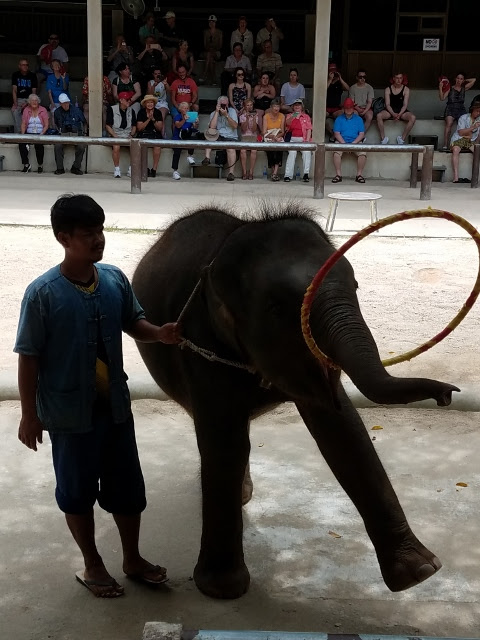Friday, March 23, Koh Samui, Thailand
A paradise of long sand beaches, spectacular coral reefs, and
swaying coconut trees, Koh Samui is Thailand’s second largest island after
Phuket. By some accounts, the island’s
name derives from the Malay word for “safe Haven.” Surely, few havens are as soothing and
idyllic, as evidenced by the sun-loving beachcombers from Thailand and beyond
who wade, swim, and lounge in the lapping tides. Until the early 1970s, this self-sufficient
community had no roadways; crossing the island required a full-day trek across
nine miles of mountainous jungle. Today,
Koh Samui retains the slower pace of simpler times. The cherished traditions of old Siamese
fishing villages, too, are preserved as tiny boats gently bob on turquoise
waters.
We usually used cruise ship tenders to go ashore when anchored offshore but today we used a pair of local tenders. Quite a difference!
A pair of inter island ferries traveling in opposite directions.
sOur first activity at the elephant area was to see the lovely Na Muang Waterfall.
A map of the entire island but developing into a significant tourist area.
A T-shirt for sale at the local market.
Women's and men's restroom signs. The folded hands symbolize respect.
Our third activity was a show by younger elephants.
The monkeys are trained to test each coconut for ripeness (by color and shaking-if no sound when shaking the coconut is not ripe).
Our fifth activity was to ride an elephant. There were stairs to climb so we could step onto the elephant.
This little guy is eight months old and has started his training by follow mom around.
It was a hot afternoon so our guide stopped to hose down our guide.
The harvested rubber sap is collected then mixed with water and an acid, stirred together, then poured into molds. The sheets are wrung out numerous times after partial drying to extract most moisture then hung out of the sun for a week to finish drying.
Today was an exciting and educational time.
Because the local pier could not accommodate our cruise ship, we anchored a mile from shore where we viewed a local fishing boat. It also looked like home.
We usually used cruise ship tenders to go ashore when anchored offshore but today we used a pair of local tenders. Quite a difference!
A pair of inter island ferries traveling in opposite directions.
On today’s Elephant Encounter shore excursion we visited an elephant camp and trekked through the jungle atop this graceful giant. Our journey began as we traveled in a 4x4 vehicle to the elephant camp. A local mom with child on back; note she is talking on cell phone!
sOur first activity at the elephant area was to see the lovely Na Muang Waterfall.
A map of the entire island but developing into a significant tourist area.
A T-shirt for sale at the local market.
Women's and men's restroom signs. The folded hands symbolize respect.
Our second activity was a Thai cooking demonstration. If anyone would like the recipe, please e-mail us.
Our third activity was a show by younger elephants.
Our fourth activity was a monkey show. Farmers us these monkeys to pick ripened coconuts (safer to avoid climbing and for avoiding poisonous snakes that live at the tops of the trees). The monkeys can pick about ten times per day what a man could.
The monkeys are trained to test each coconut for ripeness (by color and shaking-if no sound when shaking the coconut is not ripe).
The monkeys are trained to spin ripe coconuts until the stem lets the nut fall from the tree.
Most monkeys can be trained in just a few months after they are about 2 years old.
The coconuts have three eyes that are exposed after the inch thick hulls have been removed. They are then cut in half to expose the meat which is removed, shredded, and turned into milk for cooking.
Our fifth activity was to ride an elephant. There were stairs to climb so we could step onto the elephant.
It was a hot afternoon so our guide stopped to hose down our guide.
The elephants were very slow; we sat just behind the front shoulders so the ride was quite lumbering and rocky.
Our sixth and last activity was a stop for a rubber tree demonstration.
The rubber tree seed that starts it all off. The tree below was 18 inches in diameter at 6-7 years old.
The cuts in the bark are special and critical to get the maximum flow and to prevent damage to the tree. One cut drains for half a week; three trees are set up on a rotation. A half coconut shell is used to catch the liquid. The special knife below is used to make the twice weekly cut. Trees are drained for about a month each year then rotated out for the remainder of the year. Trees begin producing at six to seven years old then for two decades.
Today was an exciting and educational time.




















































Comments
Post a Comment